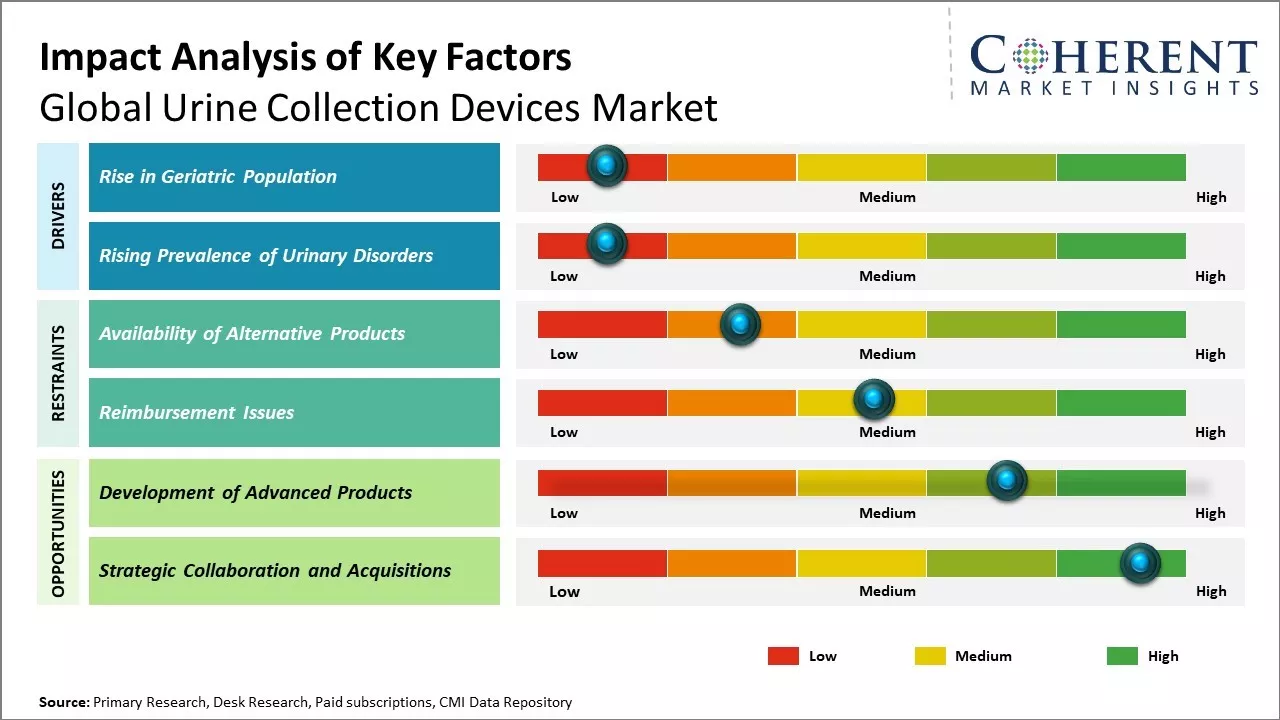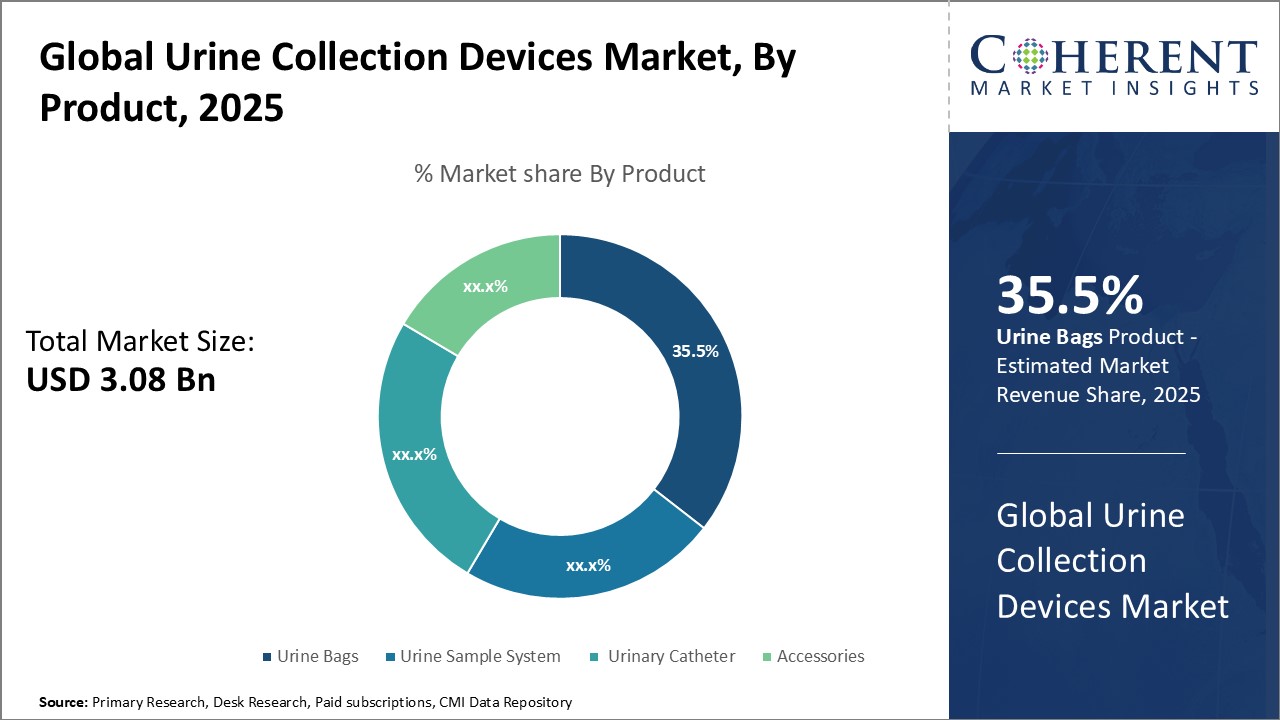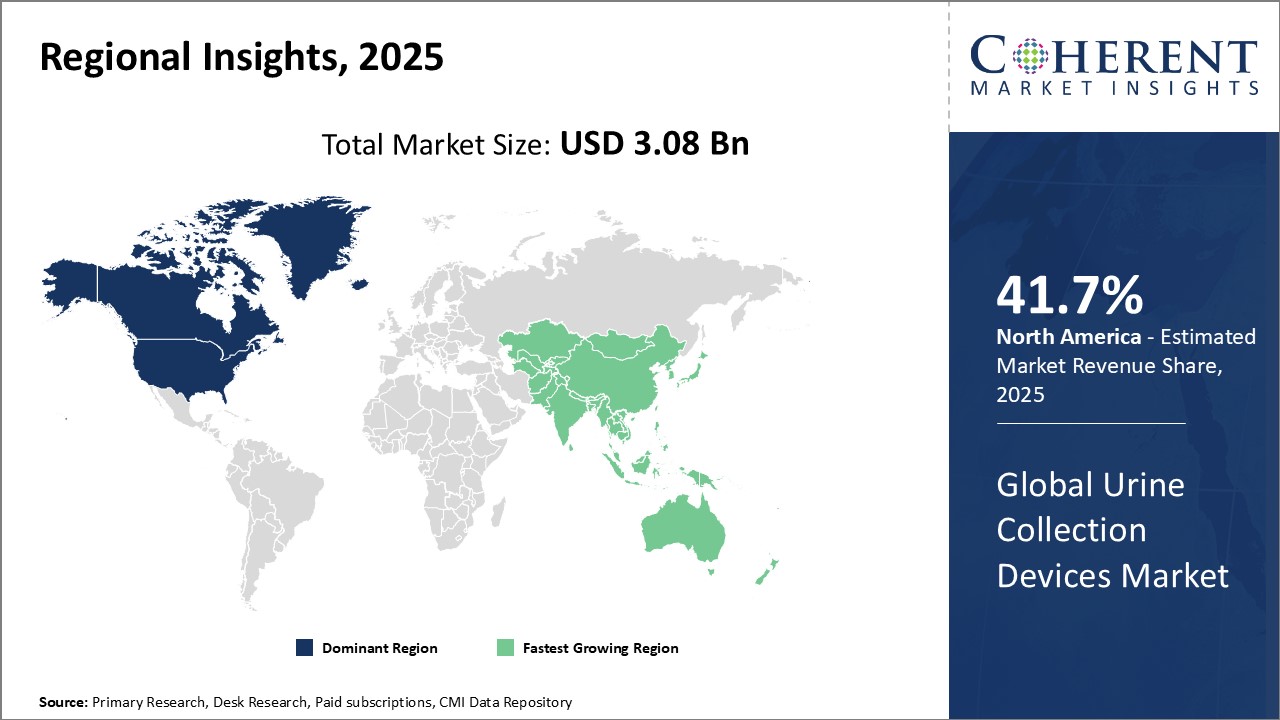Global urine collection devices market is estimated to be valued at USD 3.08 Bn in 2025 and is expected to reach USD 4.57 Bn by 2032, exhibiting a compound annual growth rate (CAGR) of 5.8% from 2025 to 2032.

Discover market dynamics shaping the industry: Request sample copy
Rising demand for urine collection devices due to growing prevalence of urinary incontinence, prostate cancer and other urological conditions can drive the market growth. Technological advancements in urine collection devices with added features like infection control, ease of use and comfort can also drive the market growth. However, high cost of these advanced devices may limit their adoption in price sensitive areas. Growing medical tourism and the development of low-cost urine collection solutions can offer new opportunities for the market players.
Rise in Geriatric Population
Growing aging population can drive the urine collection devices market growth. The percentage of people aged over 65 years is steadily increasing across developing as well as developed regions predominantly due to better healthcare infrastructure and facilities leading to improvement in life expectancy. By 2050, nearly 16% of the world's population will be aged over 65 years, an increase from current levels of approximately 8%. Aged population is highly vulnerable to developing age-related diseases and disorders. Urinary disorders are highly prevalent in the geriatric section with nearly 50% of people over age 85 years are affected by some type of urinary disorder. Rising geriatric population base subsequently increases the risk of developing urinary diseases like urinary incontinence, retention, infection, thus, boosting demand for management of these conditions. Urine collection devices are vital for long term monitoring and treatment of aged patients with chronic urinary diseases. For instance, leg bags are commonly used in completely bedridden elderly patients while urine sample collection bottles are used in diagnosis and monitoring of urinary infections.

Get actionable strategies to beat competition: Request sample copy
Rising Prevalence of Urinary Disorders
Global urine collection devices market growth is driven by rising prevalence of various urinary disorders across the globe. Urinary disorders such as urinary incontinence, urinary retention and overactive bladder have been increasing especially in the aging population. It is estimated that nearly 200 million people suffer from urinary incontinence globally. The prevalence increases substantially with age with nearly 25-45% of women and 15-30% of men above age 65 affected by some form of urinary incontinence. Overactive bladder affects nearly 550 million people worldwide. This high prevalence of urinary disorders has increased the clinical needs for effective management and diagnosis of these conditions. Urine collection devices play a vital role in management of various urinary disorders by enabling accurate urine collection and analysis. Urine collection bags are increasingly used in patients suffering from urinary incontinence as these provide a hygienic way of collecting and disposing urine without any mess. Urine collection devices that allows for collection of mid-stream urine samples are crucial for urinalysis and diagnosis of urinary tract infections. Furthermore, these devices also facilitate monitoring of various urinary conditions through collection of 24-hour urine samples for measurement of biomarkers.
Key Takeaways from Analyst:
Global urine collection devices market growth is driven by increasing prevalence of urinary disorders and rising awareness regarding non-invasive collection methods. The market is dominated by disposable urine bags and urine collection bags that are used in nursing homes and long-term care facilities. North America dominates the market due to presence of established players and rising healthcare spending. Asia Pacific is poised to be the fastest growing region due to improving healthcare infrastructure and growing medical tourism industry in China and India.
Lack of awareness about the availability of urine collection devices in developing nations can hamper the market growth. Insufficient reimbursement policies can also hamper the market growth. Ongoing research and development activities to introduce less invasive and more user-friendly products can provide significant opportunities for manufacturers. Increasing penetration in home healthcare market can further boost the market revenue through 2025. Manufacturers are further focusing on developing innovative urine collection bags with diagnostic capabilities, which can help track patient health remotely.
Global urine collection devices market remains highly competitive with presence of large as well as local players. Companies operating in this market are primarily focused on new product launches, partnerships, and geographical expansion strategies to gain higher market shares.
Market Challenges: Availability of Alternative Products
The availability of alternative products can hamper the global urine collection devices market growth. There are many substitute products available that can collect and store urine without requiring the use of medical grade urine collection devices. For example, simple plastic bottles or containers can be used to collect and store urine samples, especially for routine testing purposes. These alternative storage solutions are very cheap and easily accessible across all countries. According to the data from World Bank, more than 80% of the global population can easily access inexpensive plastic containers from their local markets to provide urine samples. The wide availability and affordability of these basic plastic alternatives can reduce demand for specially designed urine collection devices among individuals as well as hospitals and diagnostic labs. Many people and healthcare facilities in developing nations prefer using generic plastic bottles over medical-grade urine bags or bottles as these fulfill the purpose at a much lower price point. Stigma associated with certain urine collection devices among conservative populations also contributes towards favoring simple storage alternatives. For instance, according to the survey by UNICEF, nearly 60% of women in South Asian and Middle Eastern countries are hesitant to use visible urine collection bags or bottles due to cultural reservations.
Market Opportunities: Development of Advanced Products
Advanced urine collection devices can provide opportunity for the market growth. With technological developments, manufacturers are now able to provide more user-friendly and accurate diagnostic tools. New products are being developed with advanced features that promote improved healthcare outcomes. For example, some new devices allow for urine collection, analysis, and digital transmission of results all within the device itself. This integration of collection, analysis and reporting eliminates multiple steps from the process. As a result, patients spend less time providing samples and healthcare providers receive faster, more accurate diagnostic insights. With the world population aging rapidly and rising lifestyle diseases, there has been huge demand for simple, non-invasive monitoring tools. Integrated urine collection and analysis devices meet this need. Smart urine collection devices can communicate test results digitally via Bluetooth. This allows at-home monitoring and remote doctor consultations. The COVID-19 pandemic accelerated this shift towards contactless healthcare delivery. According to Project ECHO (Extension for Community Healthcare Outcomes), a program of the University of New Mexico Health Sciences Center that provides virtual consultations, the switch to telehealth during the pandemic led to explosive growth with 18 million additional virtual visits annually. Smart urine collection tools that facilitate remote care align well with this emerging model. Advanced products with features like integrated analysis, digital result transmission and remote monitoring represent a significant opportunity for global urine collection devices market growth. Streamlined diagnosis and remote healthcare delivery are expected to be long-term trends driving continued innovation and market expansion.

Discover high revenue pocket segments and roadmap to it: Request sample copy
By Product- Convenience drives reliance on urine bags
In terms of product, urine bags segment is estimated to contribute the highest market share of 35.5% in 2025, owing to their convenience and portability. Urine bags allow for on-the-go urine collection without needing bathroom access, making them ideal for those confined to beds or wheelchairs as well as outdoor expeditions. The ability to discretely attach the bag to the leg allows urine to be collected without disrupting other activities. This is particularly useful for patients undergoing rehabilitation or therapy. Urine bags also help promote sanitary bathroom hygiene in hospitals and long-term care facilities by containing odors and minimizing spills. As the global population ages and medical advancements prolong life, there will be huge demand for urine bags that empower independent living for the elderly and disabled.
By Material- Skin sensitivity elevates silicone material prominence
In terms of material, silicone segment is estimated to contribute the highest market share of 40.62% in 2025, due to its skin-friendly properties. Silicone is softer and more flexible than alternative materials like latex or rubber, reducing irritations from prolonged contact. This makes silicone especially well-suited for urinary catheters and collection bags that are often used for multiple hours. As medical care emphasizes patient comfort, silicone continues gaining preference over rougher options. Its smooth, seamless construction also helps prevent bacteria buildup. With growing awareness of various sensitivities, specialty medical supply companies are anticipated to further expand their silicone offerings.
By Gender- Enhanced male product ergonomics drive leadership
In terms of gender, male segment is estimated to contribute the highest market share of 60.7% in 2025, due to targeted design enhancements. Many male urine collection devices now feature ergonomic angles and extended funnels to facilitate a standing posture. Convex shapes conform securely while minimizing contact for improved hygiene. Customization allows for unique volume needs. Leaders strategize numerous single-use product tiers aligned with procedure lengths. As men engage more proactively in personal healthcare and prevention, demand is fueled for discreet, optimized options supporting active lifestyles. Suppliers accentuating formularized comfort and functionality are positioning ahead of less specialized approaches.

Need a Different Region or Segment? Customize now
North America dominates the global urine collection devices market with an estimated market share of 41.7% in 2025. The region has a well-established healthcare infrastructure and high healthcare spending. Many leading manufacturers of urine collection devices are headquartered in the U.S. and Canada, giving the region an edge in terms of innovative product development. Moreover, rising geriatric population prone to urological disorders can boost demand.
Stringent regulations regarding patient safety and product quality ensures the availability of high-grade medical products. This has helped North America to emerge as a major production and export hub. Several medical device companies are focusing on the U.S. through strategic deals and collaborations with local players to leverage the large market opportunities.
Asia Pacific is projected to be the fastest growing regional market. Rapid economic development, growing medical tourism, increasing healthcare expenditure and massive unmet needs boosts the uptake of urine collection devices across developing countries.
China and India represent major manufacturing and export hubs, owing to low-cost skilled labor and favorable business regulations promoting foreign investments. Domestic demand is also augmented by rising incidence of lifestyle diseases, expanding medical infrastructure and large patient pools.
Pricing pressure from local generic counterparts remains a challenge for prominent brands. To succeed in the price-sensitive APAC markets, companies are investing in cost-effective technology and collaborative research with regional diagnostic labs and hospitals. The steady influx of private capital into the healthcare sector will additionally stimulate regional demand.
Global Urine Collection Devices Report Coverage
| Report Coverage | Details | ||
|---|---|---|---|
| Base Year: | 2024 | Market Size in 2025: | USD 3.08 Bn |
| Historical Data for: | 2020 To 2024 | Forecast Period: | 2025 To 2032 |
| Forecast Period 2025 to 2032 CAGR: | 5.8% | 2032 Value Projection: | USD 4.57 Bn |
| Geographies covered: |
|
||
| Segments covered: |
|
||
| Companies covered: |
Becton, Dickinson and Company (BD), C.R. Bard, Inc., Cook Medical, Teleflex Incorporated, Medtronic plc, Smiths Medical, B. Braun Melsungen AG, Halyard Health, Inc., Stryker Corporation, Ethicon, Inc., Zimmer Biomet Holdings, Inc., Integra LifeSciences Holdings Corporation, Mölnlycke Health Care AB, 3M Company, Johnson & Johnson, Abbott Laboratories, Baxter International Inc., Boston Scientific Corporation |
||
| Growth Drivers: |
|
||
| Restraints & Challenges: |
|
||
Uncover macros and micros vetted on 75+ parameters: Get instant access to report
Share
Share
About Author
Komal Dighe is a Management Consultant with over 8 years of experience in market research and consulting. She excels in managing and delivering high-quality insights and solutions in Health-tech Consulting reports. Her expertise encompasses conducting both primary and secondary research, effectively addressing client requirements, and excelling in market estimation and forecast. Her comprehensive approach ensures that clients receive thorough and accurate analyses, enabling them to make informed decisions and capitalize on market opportunities.
Missing comfort of reading report in your local language? Find your preferred language :
Transform your Strategy with Exclusive Trending Reports :
Frequently Asked Questions
Joining thousands of companies around the world committed to making the Excellent Business Solutions.
View All Our Clients
US Reciprocal Tax Impact Analysis On Global Urine Collection Devices Market
Stay updated on tariff changes with expert insights and timely information